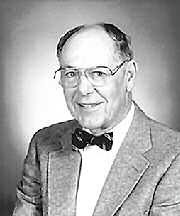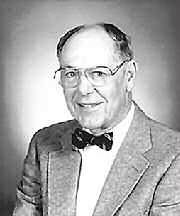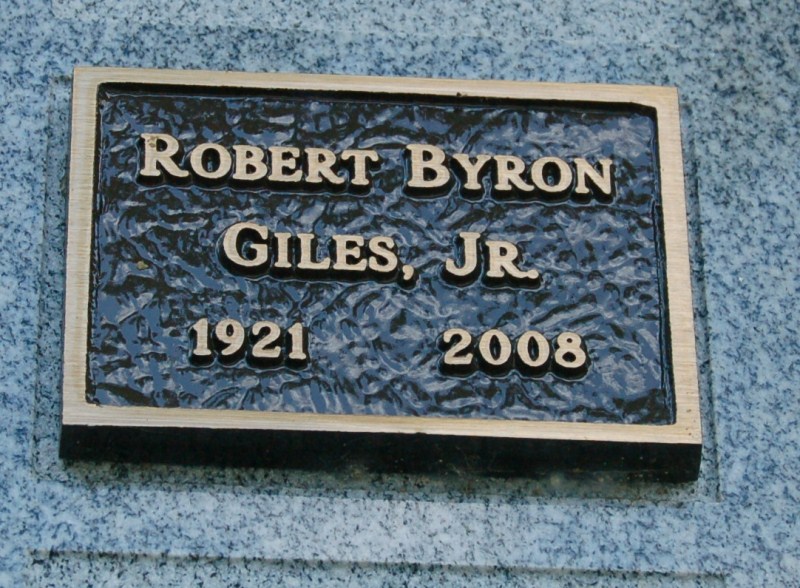Dr. Giles, 87, died Dec. 16 of natural causes at the C.C. Young retirement community in Dallas. Services were Saturday in Dallas.
"He liked the challenging cases, where he really had to use his mind," said his daughter, Caroline Banks of Minneapolis. "The researcher in him was so strong. He liked the challenge and the pleasure of diagnosing something accurately in time to be of help."Dr. Giles also liked people and often told his family about interesting patients, his daughter said.
Dr. Giles had a subspecialty in rheumatoid arthritis and saw patients from Central and South America. Some of those patients were accompanied by their extended families.
"The whole office would shut down, because he had not only the spouse, but aunts and uncles and children of these people from out of the country," Dr. Banks said.
Dr. Giles was born in Dallas, where he attended Texas Country Day School, now St. Mark's School of Texas.
Dr. Giles became a researcher after graduating from Dartmouth College. "He was at the nuclear physics department at MIT," his daughter said. "He didn't know it at the time, but he was involved with the Manhattan Project." Not knowing he was helping the Army develop the first atomic bomb, Dr. Giles repeatedly tried to enlist to serve in World War II. He had twin uncles who were generals in the Army Air Forces, his daughter said. "He kept wanting to enlist, but he was told, 'No, your work here is too important,' " his daughter said.
In 1943, Dr. Giles married Patricia Wellington. Mrs. Giles died in 1992. After the war, Dr. Giles attended medical school, graduating from a two-year program at Dartmouth and completing his medical degree at Harvard University.
Dr. Giles completed his internship and began his residency and a fellowship at Massachusetts General Hospital in Boston. His studies, however, were interrupted when he was recruited as an Army medical officer for service during the Korean War. He was chief medical officer with the 8228th Mobile Army Surgical Hospital in Korea. Dr. Giles soon found himself doing research in the war zone. Some Korean soldiers and civilians brought to his hospital had a disease unknown to Western medicine, his daughter said. "He was one of the first Westerners to identify and research hemorrhagic fever," Dr. Banks said. "Because of his previous interest in research at MIT, he was very curious about the nature of this virus. He didn't want to just treat patients; he wanted to understand what it was." The hantavirus was originally known as Korean hemorrhagic fever, and gets its name from the Hantaan River in Korea. In 1953, Dr. Giles received an Army commendation for meritorious war-zone research, treatment and training in Korea. After his military service, Dr. Giles completed his residency in Boston. In the late 1950s, Dr. Giles returned to Dallas, where he was an assistant professor of medicine in charge of a research laboratory at what is now UT Southwestern Medical Center.
In the early 1960s, Dr. Giles entered private practice with his father, Robert B. Giles Sr., at the Medical Arts Building in downtown Dallas. When his father retired, Dr. Giles moved his practice to Presbyterian Hospital, where he became chief of the medical staff, his daughter said.
Dr. Giles was an accomplished and avid golfer. He also enjoyed sailing and watercolor painting. In addition to his daughter, Dr. Giles is survived by his wife, Ann Baker Giles of Dallas; another daughter, Phoebe Giles of Dallas; two sons, Ben Giles of Bishkek, Kyrgyzstan, and Richard Giles of Great Barrington, Mass.; three sisters, Frederica Reily of Baton Rouge, La., Ann Kimbrough of Dallas and Marie Louise Baldwin of Dallas; five grandchildren; and three great-grandchildren.
Dr. Giles, 87, died Dec. 16 of natural causes at the C.C. Young retirement community in Dallas. Services were Saturday in Dallas.
"He liked the challenging cases, where he really had to use his mind," said his daughter, Caroline Banks of Minneapolis. "The researcher in him was so strong. He liked the challenge and the pleasure of diagnosing something accurately in time to be of help."Dr. Giles also liked people and often told his family about interesting patients, his daughter said.
Dr. Giles had a subspecialty in rheumatoid arthritis and saw patients from Central and South America. Some of those patients were accompanied by their extended families.
"The whole office would shut down, because he had not only the spouse, but aunts and uncles and children of these people from out of the country," Dr. Banks said.
Dr. Giles was born in Dallas, where he attended Texas Country Day School, now St. Mark's School of Texas.
Dr. Giles became a researcher after graduating from Dartmouth College. "He was at the nuclear physics department at MIT," his daughter said. "He didn't know it at the time, but he was involved with the Manhattan Project." Not knowing he was helping the Army develop the first atomic bomb, Dr. Giles repeatedly tried to enlist to serve in World War II. He had twin uncles who were generals in the Army Air Forces, his daughter said. "He kept wanting to enlist, but he was told, 'No, your work here is too important,' " his daughter said.
In 1943, Dr. Giles married Patricia Wellington. Mrs. Giles died in 1992. After the war, Dr. Giles attended medical school, graduating from a two-year program at Dartmouth and completing his medical degree at Harvard University.
Dr. Giles completed his internship and began his residency and a fellowship at Massachusetts General Hospital in Boston. His studies, however, were interrupted when he was recruited as an Army medical officer for service during the Korean War. He was chief medical officer with the 8228th Mobile Army Surgical Hospital in Korea. Dr. Giles soon found himself doing research in the war zone. Some Korean soldiers and civilians brought to his hospital had a disease unknown to Western medicine, his daughter said. "He was one of the first Westerners to identify and research hemorrhagic fever," Dr. Banks said. "Because of his previous interest in research at MIT, he was very curious about the nature of this virus. He didn't want to just treat patients; he wanted to understand what it was." The hantavirus was originally known as Korean hemorrhagic fever, and gets its name from the Hantaan River in Korea. In 1953, Dr. Giles received an Army commendation for meritorious war-zone research, treatment and training in Korea. After his military service, Dr. Giles completed his residency in Boston. In the late 1950s, Dr. Giles returned to Dallas, where he was an assistant professor of medicine in charge of a research laboratory at what is now UT Southwestern Medical Center.
In the early 1960s, Dr. Giles entered private practice with his father, Robert B. Giles Sr., at the Medical Arts Building in downtown Dallas. When his father retired, Dr. Giles moved his practice to Presbyterian Hospital, where he became chief of the medical staff, his daughter said.
Dr. Giles was an accomplished and avid golfer. He also enjoyed sailing and watercolor painting. In addition to his daughter, Dr. Giles is survived by his wife, Ann Baker Giles of Dallas; another daughter, Phoebe Giles of Dallas; two sons, Ben Giles of Bishkek, Kyrgyzstan, and Richard Giles of Great Barrington, Mass.; three sisters, Frederica Reily of Baton Rouge, La., Ann Kimbrough of Dallas and Marie Louise Baldwin of Dallas; five grandchildren; and three great-grandchildren.
Family Members
Sponsored by Ancestry
Advertisement
Advertisement










